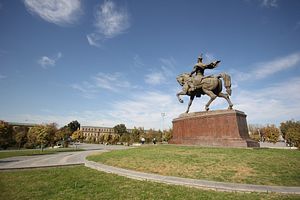Until recently, investors wishing to purchase stakes in the largest open-pit gold mine in the world, the former KGB building in Tashkent, or the Uzbek Coca-Cola plant would have to contend with a sigh. Now, as part of a highly-publicized privatization program under President Mirziyoyev, stakes in these and other state assets are for sale.
Uzbekistan is slated to fully or partially sell 620 state-owned enterprises, including some of the country’s largest energy and financial firms. Among those to be partially privatized are Uzbekneftegaz, (which contributes 15 percent of the country’s GDP), Navoi Mining and Metallurgical Combine, Uzbekistan Airways, Uzbekistan Railways, and car maker Uzavtosanoat. Over five hundred companies in the chemical, tourism, manufacturing, food and beverage, and finance sectors are planned to be fully privatized.
The privatization scheme was announced in early 2020 and outlined further in a November 2020 presidential decree. The decree clarified the state’s reform objectives, but privatization had already begun: The Uzbek mission to the UN reported the May 2020 sale of 299 state assets worth $33 million.
These reforms are led by President Shavkat Mirziyoyev, who succeeded Uzbekistan’s long-serving Islam Karimov after his death in 2016. Mirziyoyev’s reforms started small and quickly accelerated; closure of the notorious Jaslyk prison, formal abolition of slavery, and border relaxation with neighboring states among them. Mirziyoyev’s reforms led the Economist to declare Uzbekistan the “2019 Country of the Year.”
Yet there is reason to take a closer look at the privatization push.
For one, the state is not actually privatizing its large and strategically important assets: selling 15 percent of a state-owned company is fundraising, not privatizing. The 299 assets sold in early 2020 for $33 million captured an average price of about $100,000 each, drops in the bucket. The most high-profile sale of state assets thus far has been Hotel Uzbekistan, which sold to a Singaporean film company. Yet, the opacity of the hotel deal was noteworthy and invited comparisons to circular asset sales, wherein state assets are “privatized” in deals between the government and its private affiliates.
This is also not the first time Uzbekistan has announced massive privatization scheme; a 2007 Reuters article outlined suspiciously similar plans. And a 2017 ADB paper notes “[Privatization] efforts have been focused on small and auxiliary enterprises and often on unused real estate property,” an apt descriptor of the current privatization plan, a hodgepodge for-sale portfolio of rural ski resorts, bazaars, and cooking oil manufacturers.
Hither and thither sales of 15 percent stakes are unlikely to radically alter Uzbekistan’s energy industry, a top contributor to GDP and among the most inefficient in the world. However, the state seems more committed to privatizing the financial sector. A May 2020 decree outlines the plan to reduce the state-share of system assets from 85 percent to 40 percent by 2025 through the full sale of six large state-owned banks. As of March 2020 the ERBD was allegedly considering purchasing stakes in two of them to assist transformation. The six banks for sale include the second and third-largest by assets.
At the same time, a February 2020 decree expanded the Central Bank’s oversight over commercial banks, granting it the power to fire bank management and board members, inspect systems and procedures whenever it sees fit, and prohibit payment of dividends. This illustrates the state’s abiding ambivalence toward privatization: on one hand, trying to attract hard currency inflows with privatization and social reforms; on the other, a deep-rooted reluctance to relinquish centralized control.
The state plans to fully sell out of small, non-core assets and auction non-controlling stakes in certain key assets; this an old blueprint for Uzbekistan with a new splash of investor-friendly social reforms on the side. But if the goal of reforms is to intimate a fertile business environment and grow FDI, it seems to be working: FDI grew from $1.6 billion in 2018 to $4.2 billion in 2019, according to the U.S. Department of State.
Previous privatization efforts failed when buyers didn’t bite. The current program reveals the same lukewarm attitude toward privatization, but 2021’s economic landscape is different from years prior. A quasi-private banking sector combined with an increasingly globalized economy, persistently low yields, and Central Asia’s waxing geopolitical relevance could tilt the balance toward Uzbekistan.
Corissa Steiner is a political risk analyst focused on South and Central Asia.

































